Welcome to our step-by-step guide on propagating houseplants in water. Discover the simple and rewarding process of growing new plants from cuttings, creating a lush indoor oasis.
About Propagating Houseplants in Water

Propagating houseplants in water is an excellent way to get free plants. We love free plants!
©ArtCreationsDesignPhoto/Shutterstock.com
Propagation is a way of growing new plants from existing ones. It can be done through several methods, such as division, cuttings, and layering. Propagating houseplants in water is one of the simplest and most popular ways to create more plants from your favorite houseplants.
By propagating your houseplants in water, you’ll be able to enjoy vibrant greenery with minimal effort! Here are some step-by-step instructions
Step-by-Step Guide to Propagating Houseplants in Water
Here is a step-by-step guide to help you learn all about propagating houseplants in water. Once you learn how to do this, you will be swimming in free plants!
Step One—Make the Cut
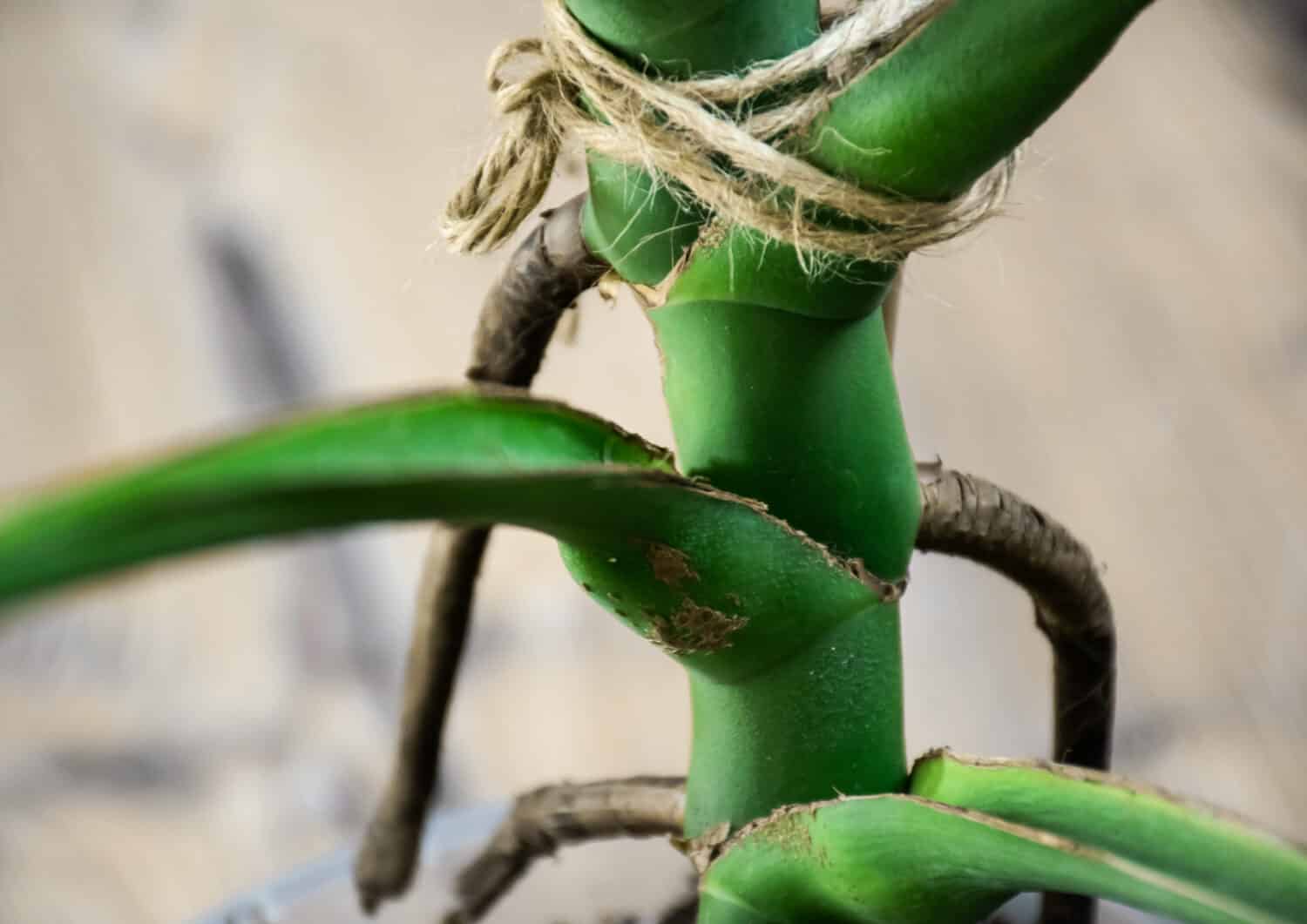
Make your cut right below the node. The nodes are tiny root buds that will turn into roots.
©Amverlly/Shutterstock.com
Cut a healthy stem off of the parent plant. Make sure that the stem cutting has at least one node. Make your cut about half to a quarter inch below a node. Use sterilized scissors or pruners.
Step Two—Remove Lower Leaves

Strip all of the lower leaves from the stem and leave the top-most 3 or 4 leaves to grow.
©New Africa/Shutterstock.com
Remove the leaves from the lower half of the stem. This will help ensure that your cutting has access to enough light and air circulation while in water. It also keeps the leaves from decaying in the water and getting slimy. The bare end of the stem will go in the water.
Step Three—Place in Water

Move the stem cuttings into a small container of tap water. Make sure no leaves are below the water line.
©Lifesummerlin/Shutterstock.com
Place the stem cutting into a glass or jar filled with fresh water. It is perfectly fine to use tap water for this. Make sure that at least one node is submerged under the surface of the water so it can root properly.
Step Four—Provide Light
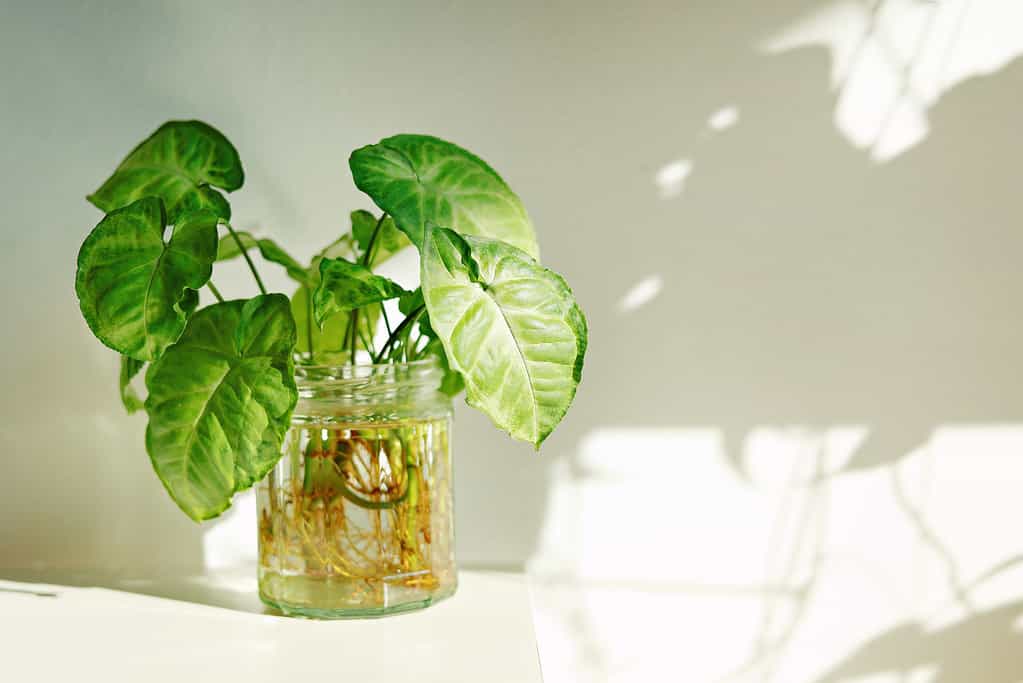
When propagating houseplants in water, place them in filtered, bright light, not direct sun.
©Pikusisi-Studio/ via Getty Images
Place the container in bright, indirect sunlight. An east or west windowsill is a good idea.
Step Five—Change the Water

Be sure to provide your cutting with fresh water full of oxygen every few days.
©NatVV/Shutterstock.com
Change out the water every few days to prevent bacteria or mold growth. Fresh water will have higher levels of oxygen, so don’t forget this step.
Step Six—Have Patience
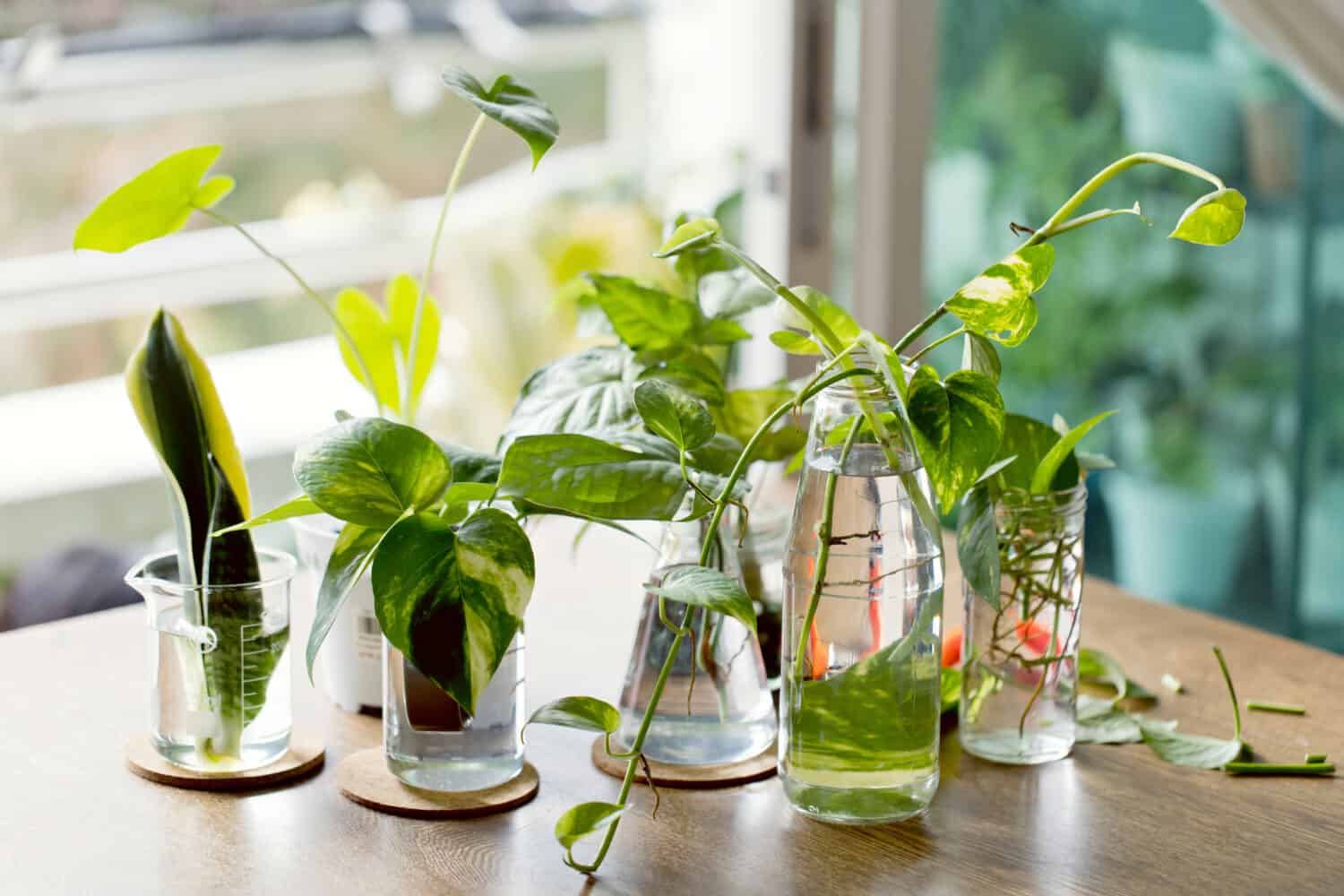
When you are propagating houseplants in water, surely waiting is the hardest part.
©AngieYeoh/Shutterstock.com
Wait for a few weeks, and your stem cutting should start forming roots! Once you see roots that are longer than two inches, it’s time to transfer your houseplant into potting soil.
How to Transplant Your Cutting to Soil

When propagating houseplants in water, you can eventually move them to a regular pot with soil.
©FotoHelin/Shutterstock.com
After your stem cutting has been successfully propagated in water, you will see 2 or 3 inches of fresh roots form. Now, it’s time to move your plant baby to a pot with soil. Here is how you do that
Step One—Fill your pot with a light, well-draining soil mix. We recommend using a mix that is made for that particular type of plant.
Step Two—Dig a hole in the center of the pot slightly larger than the stem cutting’s root ball. Gently remove your cutting from its water container and place it inside the hole you just dug. Make sure to fill all air pockets around it with additional soil so there are no gaps between roots and soil.
Step Three—Gently press down on the edges of the pot to secure your cutting in place. Water it lightly and make sure it’s evenly distributed throughout the soil.
Step Four—Place your newly transplanted houseplant in the type of lighting that is ideal for that plant. The majority of houseplants prefer bright, indirect sunlight.
Step Five—Water your new plant regularly. Until the roots have fully developed, it may need more water than a full-grown plant of that type. So keep a careful eye on moisture levels for the first month or two while the roots are growing larger.
Why Should You Be Propagating Houseplants in Water?
Propagating houseplants in water is an incredibly easy and successful way to expand your plant collection. This is an easy way to get free plants to keep or share with friends and family. Doesn’t everyone love getting a houseplant as a gift? It’s a great way to get unrestricted plants while getting creative with styling your home. Propagating in water eliminates the hassle of soil messes, as well as reducing the chance of disease or fungus spreading through multiple plants. Plus, it takes almost no effort compared to other propagation methods like division and layering!
10. Types of Houseplants That Propagate Easily in Water
When it comes to propagating houseplants in water, there are dozens of houseplants that adapt to growing roots in water. Be sure not to let the roots grow too long in the water, or they have a hard time adjusting to life in the soil. Here are a few of our favorites!
1. African Violet
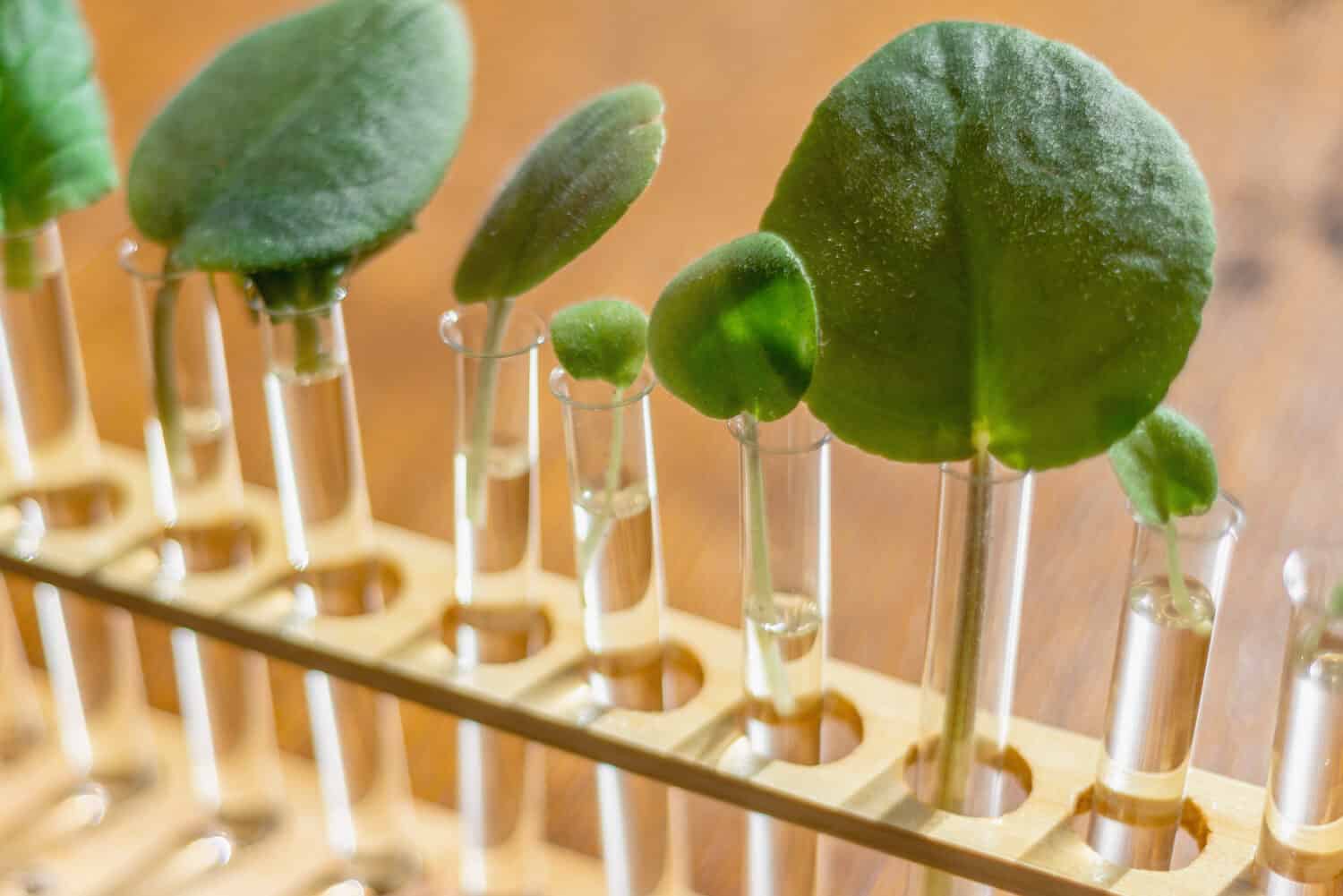
When propagating houseplants in water, one of the easiest of them all is the African Violet.
©pp1/Shutterstock.com
Propagating African violets in water is a great way to clone the parent plant, although some multicolor violets may produce solid-colored flowers. To start, select young, healthy leaves and cut them off with two inches of stem. Place the leaves into bottles with narrow necks so they stay dry and suspended. It will take about a month for roots to form, and eventually, a tiny plantlet will emerge with its own crown.
2. Begonia
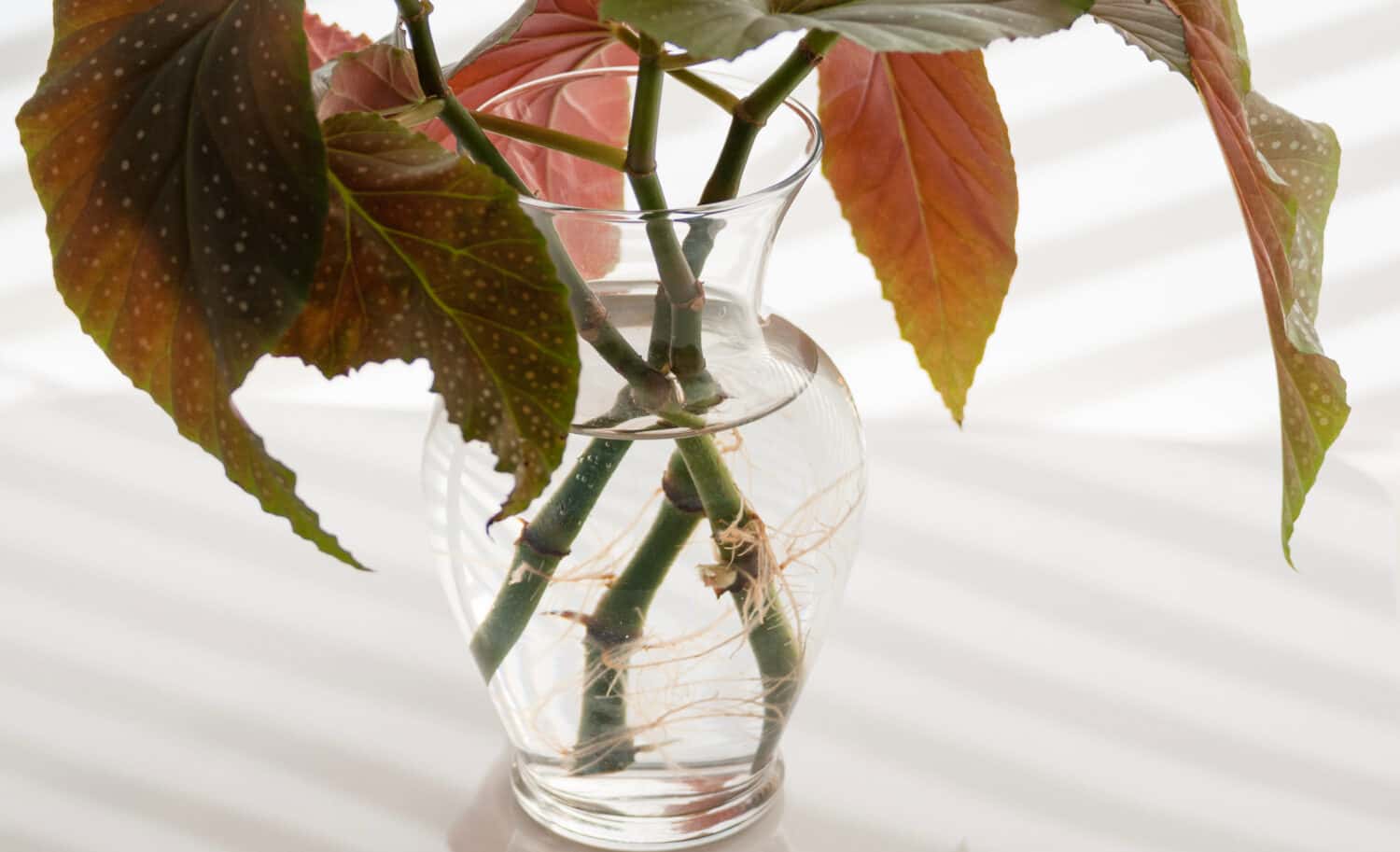
Can begonias are very easy to propagate in water and have very obvious and easy-to-spot nodes.
©SGuillory/Shutterstock.com
If you want to propagate begonias in water, the hardy wax begonia is a good place to start, as its knobby leaf nodes form roots easily. Even the more delicate rex and tuberous begonias can be propagated in water, and you only need one leaf to begin the process. Roots may take a couple of months to form, so make sure to change the water weekly to prevent the development of bacteria that could cause rot.
3. Coleus
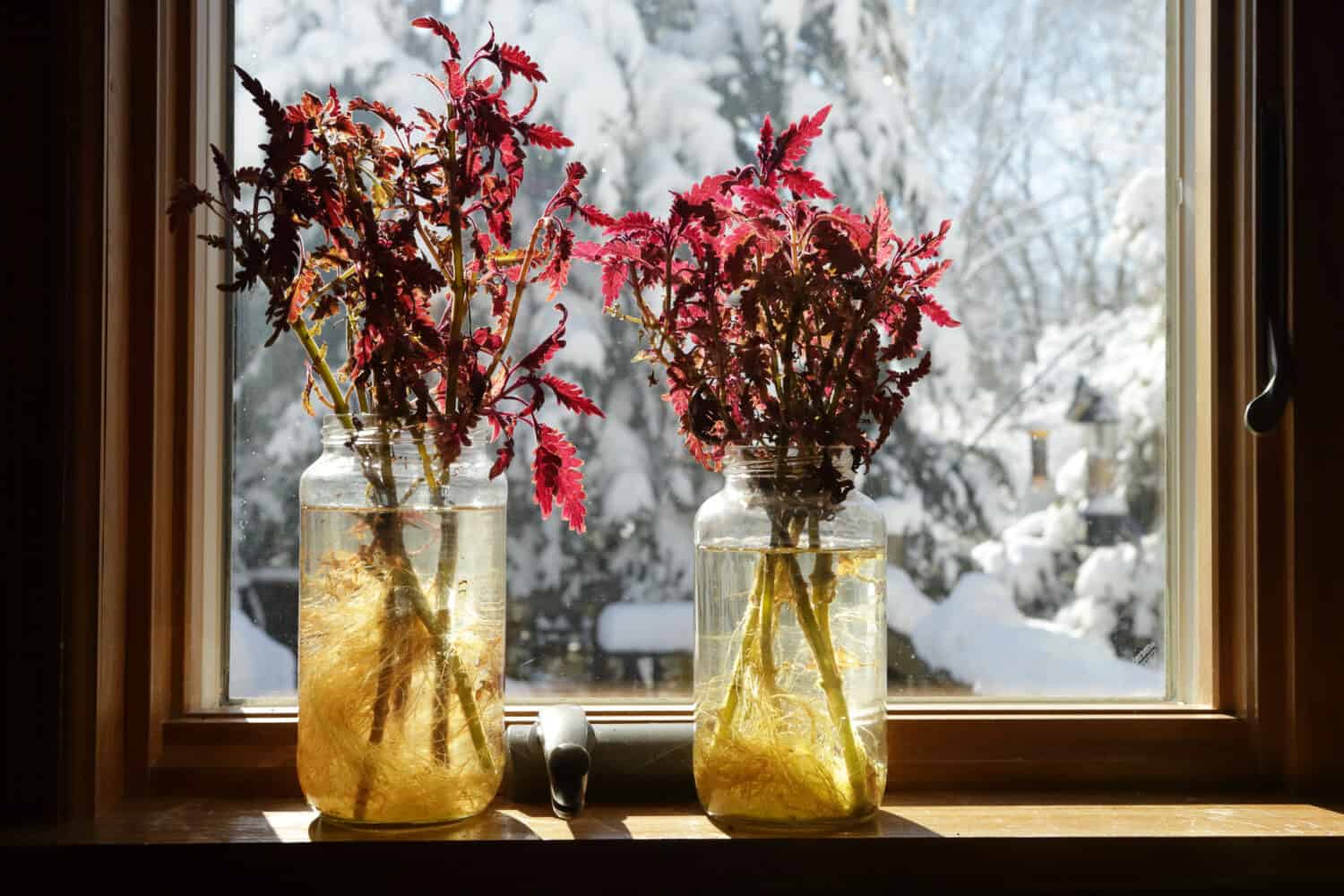
If you decide you like propagating houseplants in water, coleus can grow permanently in a jar of water.
©StephenVanHove/Shutterstock.com
Coleus plants are becoming more and more popular, but they can be expensive. Fortunately, it is easy to propagate them in water in order to create a colony of beautiful plants. Cut a six-inch stem and remove the leaves from the bottom four inches. Then, place the cutting in a glass or vase of water, and roots should begin to form in several weeks. As an added bonus, adding some fertilizer to the water during water changes will help your coleus plants stay healthy.
4. Philodendron
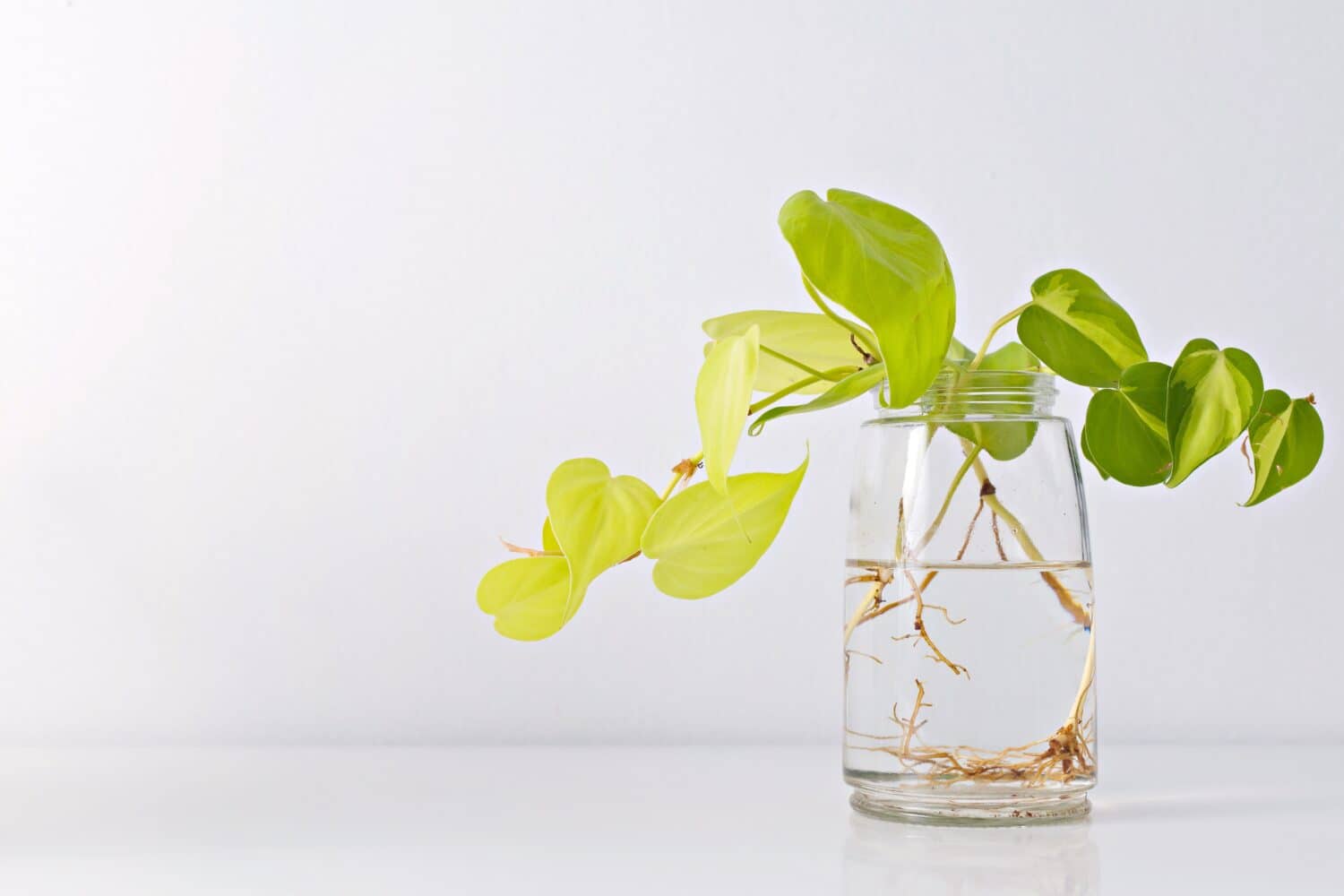
Philodendron is an easy plant to propagate in water because it has nodes that are easy to find.
©AngieYeoh/Shutterstock.com
This incredibly straightforward houseplant is an assured way to begin propagating plants in water. A well-established philodendron won’t mind giving a few of its stems to water cultivation, and they look attractive spread out in vases of various sizes and colors. Philodendron plants do well in all kinds of light conditions, but if there appears to be more stem than leaf development on your plants, brighter lighting will generate more leaves.
5. Tradescantia

If you are brand new to propagating houseplants in water, give Tradescantia a try. It never fails!
©Elena Loginova/Shutterstock.com
If you’re interested in propagating houseplants in water, spiderwort (Tradescantia) is one of the easiest. The varieties with zebra stripes and purple leaves are perfectly suited to life indoors. If you look closely at the leaves along the stem, you’ll see root buds just waiting to sprout. By adding some stems to a jar or vase of water, you can grow Tradescantia babies for your collection. However, spiderwort can grow aggressively and should be pruned regularly.
6. Pothos

You can end up with dozens of free pothos plants from the one mother plant by propagating cuttings.
©TY Lim/Shutterstock.com
You can’t fail at propagating houseplants in water with the beloved pothos. This fast-growing plant has pointed, heart-shaped leaves that may have white, yellow, or pale green striations. In order to propagate it, cut a piece of pothos vine that has three or four nodes and remove the leaves from the bottom as they will rot in water. Pothos can grow over a foot in a single month.
7. Chinese Evergreen

Aglaonema roots easily in a glass of water.
©dropStock/Shutterstock.com
Chinese Evergreen is a tropical plant with soft green leaves native to Asia. To propagate it in water, use a sterilized pruner to cut a healthy six-inch stem from a live Chinese Evergreen. Place the cut end into water and take off any leaves that are underwater. Roots should appear within three to four weeks. Put the plant in indirect sunlight and replace the water every 3 days or so when it starts to look murky.
8. English Ivy

There are several ways to propagate the Hedera helix. One is by propagating houseplants in water.
©Caterina Trimarchi/Shutterstock.com
English ivy has beautiful evergreen leaves. If you want to propagate a cutting, it is simple to do so in water, and it will take around two to three weeks for the roots to form. Cut off any leaves that are located at the bottom of the cutting before placing them in a jar. Put the water container on a window sill that gets plenty of light.
9. Maranta

When propagating houseplants in water, cut maranta stems below the nodes where the stems branch.
©Ольга Симонова/iStock via Getty Images
Maranta (prayer plant) is an evergreen herbaceous perennial native to South and Central America. It has striking arrowhead-shaped leaves that are marked with pewter gray or dark green veins on a background of lighter shades of green, white, or pinkish purple with pale green striations. To propagate it in water, cut off a healthy stem just below a node and remove the lower leaves so they won’t rot. Place the cutting into fresh water and keep it out of direct sunlight until it starts to root.
10. Monstera
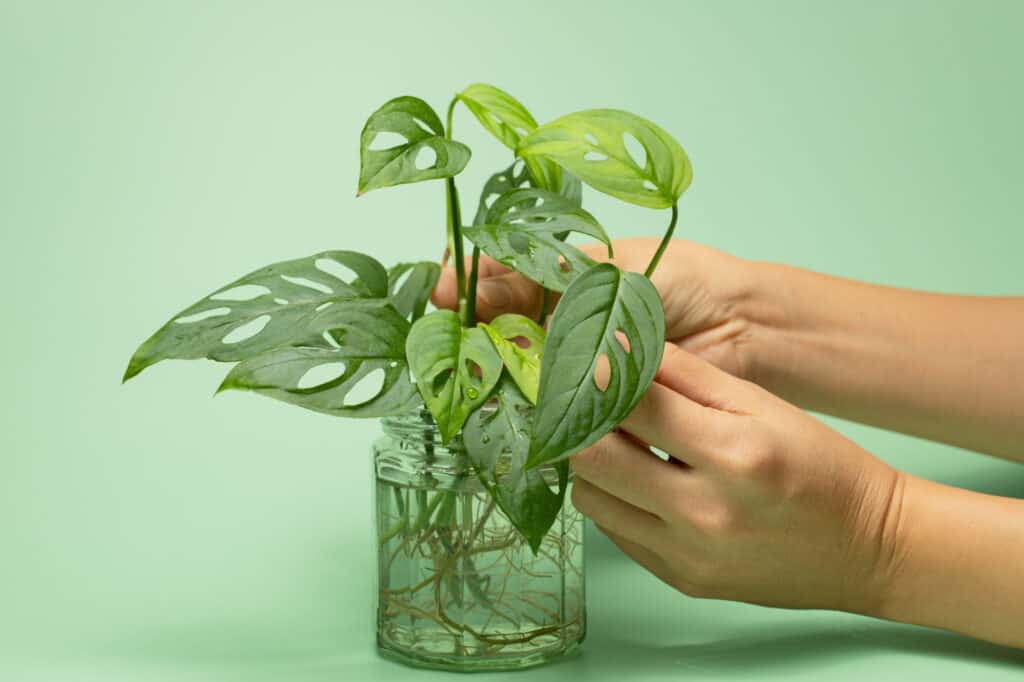
Nothing is more fun than getting free plants by propagating houseplants in water.
©AngieYeoh/Shutterstock.com
Monstera is a tropical plant native to the rainforests of Central and South America. It’s popular for its large, heart-shaped leaves that have natural holes in them. To propagate it in water, you’ll need to take a cutting of a healthy stem just below a node. Newer stems seem to propagate with better success than older ones. Place the cutting into fresh water and wait two to four weeks.
Thank you for reading! Have some feedback for us? Contact the AZ Animals editorial team.








